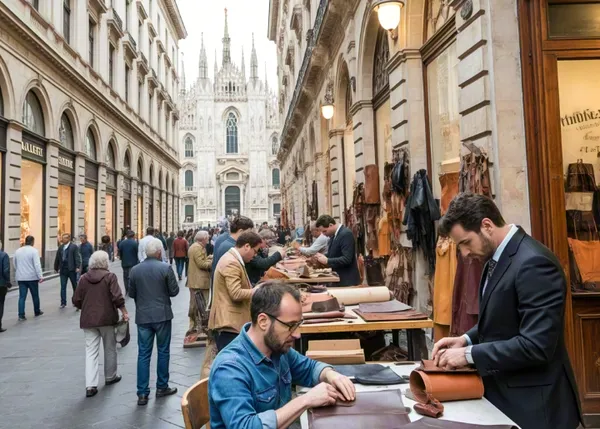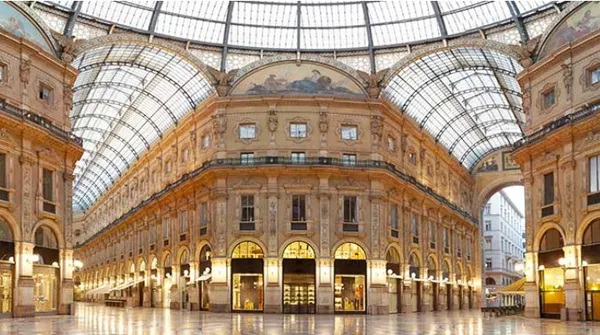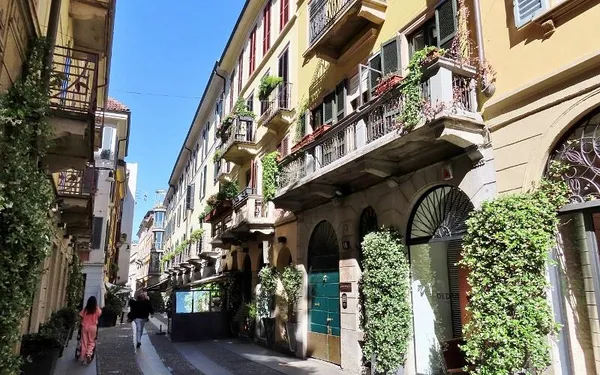
The leather market in Italy is not like that in regions such as Guangzhou, China, where there are some concentrated leather commodity markets. Unlike Florence, Milan does not have a centralized leather market. However, the leather goods market in Milan, Italy, is one of the most renowned in the world, famous for its high-quality craftsmanship, luxury brands and avant-garde designs.
This article will explore the leather bag markets in Milan, you can easily get to know the leather market before going to Milan.
Milan is the world center of leather and fashion
Milan is one of the world’s top fashion capitals. The flagship stores and headquarters of brands such as Prada, Armani, Gucci and Fendi are all located here! Apart from big brands, Milan also has many small workshops that produce handcrafted leather bags, wallets, belts and shoes.
The biennial leather and tanning trade fair Lineapelle is held in Milan every February and September. It attracts approximately 1,300 exhibitors and over 20,000 attendees from around the world. 40% of the global leather transactions are concluded here, with a transaction value exceeding 113 billion US dollars.
Milan is also very outstanding in export trade. Italy is the world’s fourth-largest exporter of leather goods, and Milan, as a fashion capital, concentrates over 60% of the country’s leather trade. Switzerland, France, the United States, Japan and Germany are its major export markets, demonstrating the competitiveness of Milan leather products in the global high-end market.
Milan's leather goods market and a gathering place for manufacturers
1. The Golden Quadrilateral (Quadrilatero della Moda) - Luxury shopping area
Quadrilatero della Moda is the most prestigious luxury shopping core area in Milan, gathering the world’s top luxury brands, flagship stores and high-end leather goods specialty stores.
Located in the heart of Milan, this area is a pilgrimage site for fashion enthusiasts. The prime area surrounded by four famous streets, namely Via Montenapoleone, Via della Spiga, Via Sant’Andrea and Via Manzoni It can be regarded as a symbol of Italian fashion style and exquisite craftsmanship.
Via Montenapoleone
This street is home to Milan’s top leather boutiques and luxury flagship stores, including top luxury brands such as Prada, Gucci and Louis Vuitton.
Via della Spiga
This elegant pedestrian street is home to Bottega (classic woven leather), Tod’s (iconic driving shoes and handbags), and Loro Piana (top-quality cashmere leather goods).
Via Sant’Andrea & Via Manzoni
This street is also home to many flagship stores of various brands. The historical headquarters of Giorgio Armani and Fendi (with its unique leather goods design) are both located here.
As the peak representative of Italian leather craftsmanship, Quadrilatero della Moda is the first choice for purchasing designer handbags, fine leather shoes or custom leather jackets, perfectly presenting the exquisite quality of world-class leather goods.

2. Galleria Vittorio Emanuele II - High-end Shopping Street
Galleria Vittorio Emanuele II, this century-old shopping corridor not only has stunning architecture, but is also the most famous shopping corridor in Italy. It was built in the Neo-Renaissance style and is one of the greatest examples of iron architecture in Europe. This building has existed since 1877 and is named after the first king of the Kingdom of Italy.
Galleria Vittorio Emanuele II has a magnificent entrance to the Arc de Triomphe, standing majestically beside the Milan Cathedral. Its floor plan is in the shape of a cross, the intersection is called octagonal, and the central dome is 47 meters high.
This luxurious 19th-century glass-topped cylindrical dome tunnel, brimming with the splendor of the Belle Epoque, is a bustling, noisy and colorful high-end shopping center featuring iconic shopping malls and leather goods.

3. Brera District - Milan's Bohemian fashion leather paradise
Brera is located between art galleries and cobblestone streets. Compared with the luxurious quadrilaterals of Milan, Brera offers a more intimate leather shopping experience, allowing you to enjoy the unique handcrafted leather craftsmanship.
Brera has long been a gathering place for artists, with a strong Bohemian atmosphere, attracting creative people and those who appreciate artistic expression. Meanwhile, Brera offers high-end boutiques, antique shops, and unique concept stores.
Top Leather Spots in Brera
Pellini Firenze (Via Solferino) : Florentine style plant-tanned leather goods.
La Bottega di Brera (Via Fiori Chiari) : Customizable wallets and folders.
Laboratorio Parrucchiere (Via Madonnina) : Quirky upgraded leather accessories.
Brera proved that the leather industry in Milan is not just about showing off – it’s about the soul.
4. Navigli District: The handcrafted leather and vintage center of Milan
In addition to the iconic canals, Navigli blends Bohemian style with the culture of handcrafted leather. This community is an ideal choice for handcrafted works to stay away from mainstream luxury goods. Many artisans accept personalized requests (letter combinations, unique dyes).
Why is it worth buying leather products at Navigli?
Handmade and sustainable development – Studios like Cuoio e Cuore specialize in producing eco-friendly plant-tanned leather goods.
Retro and upgraded discoveries – Boutiques like Bivio Milano sell second-hand designer bags (Gucci, Ferragamo) at lower prices.
Top Leather Spots in Navigli:
Pelletteria Artigiana Navigli (Via Valenza) : The family has been in business since 1985 and is renowned for its durable briefcases.
Vicolo Fabbrica (Alzaia Naviglio Grande) : A concept store featuring independent leather designers.
Mercatone dell ‘Antiquariato (Last Sunday of each month) : Vintage leather jackets and leather pants from the antique market.
In the Navigli district, it is proven that Milan’s leather industry has transcended the glamorous storefronts.
5. Other leather goods markets
Historical core: Via Spartaco
The unremarkable Via Spartaco conceals Milan’s most secretive secrets – lined with leather workshops that supply top fashion companies. This is:
Eighty percent of the leather used by luxury brands in Milan is purchased from outside.
The traditional method of tanning vegetables has encountered cutting-edge treatment methods.
Making an appointment for a visit can help you discover exclusive materials (think of pythons and stingrays).
Via Spartaco, specializing in high-end calfskin, crocodile leather and exotic leather, is most suitable for wholesale buyers and brand representatives.
Modern Innovators: Isola District
The former industrial area of Milan now houses avant-garde leather workshops:
Laboratorio Cuoio Contemporaneo: pushing the boundaries of 3d molded leather
EcoPelle Milano has been a pioneer in chromium-free tanning since 2002
Hidden Gem: San Maurilio
This quiet community offers:
A family workshop using 19th-century technology
Customize gloves for the opera stars of La Scala Opera House
Limited edition works from emerging designers
Corso Buenos Aires: There are many affordable choices, mid-range Italian leather brands (Furla, Coccinelle).
The main leather activities in Milan
Lineapelle: As the world’s leading leather exhibition, Lineapelle is held twice a year in Milan, showcasing the latest trends in leather, accessories, components, footwear materials, synthetic materials and textiles. It attracts international exhibitors and buyers, making it a must-visit place for industry professionals and the world’s largest leather market. The event for the second half of 2025 will be held at the Milanro Town Exhibition Center from September 23rd to 25th. The event for next year will be held from February 11th to 13th, 2026.
MIPEL: Another important leather goods exhibition, MIPEL focuses on bags, small leather goods and fashion accessories. It is held twice a year and serves as a platform for discovering new collections and establishing connections with leading brands.
MIFUR: Focusing on fur and leather clothing, MIFUR is an important event for those interested in high-end fur and leather fashion.
Tips for shopping in Milan leather bag markets
Schedule: Plan your visit around major leather exhibitions or market days to maximize your shopping opportunities.
The best time to visit: Between 10 a.m. and 12 p.m., when artisans have the most time.
Research: Search for specific stores or brands that interest you in advance to ensure you don’t miss out.
Customization cycle: For customized orders, reserve 6 to 8 weeks of production time.
Bargaining: At flea markets or small stores, don’t be afraid to bargain, especially if you have bought a lot of things. From antiques priced at 50 euros to custom-made masterpieces at 5,000 euros, Milan’s leather market offers unparalleled diversity.
Quality inspection: Pay attention to the quality and craftsmanship of the leather, especially when purchasing vintage or handcrafted items.
Conclusion
The leather goods market in Milan remains a stronghold of craftsmanship, innovation and niche appeal. Despite short-term pressure, the long-term growth driven by sustainability, intelligent design and customization is expected to support its recovery, especially in the high-end and handcrafted sectors.
